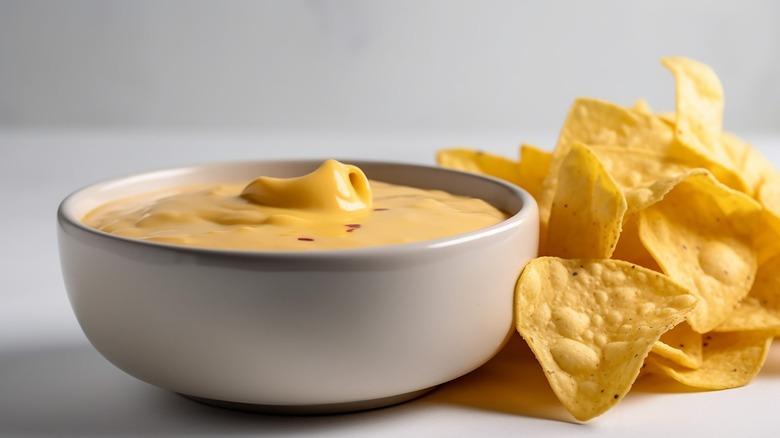The Melting Mistake That Ruins Nacho Cheese
Nacho cheese just makes game day snacks and weekend movie nights a whole lot better with its velvety richness. It's great on more than just chicken nachos; imagine it on a quick chicken adobado street taco while you're lounging in front of the TV. And making the sauce yourself is a game-changer. While canned nacho cheese is available and is the most convenient option, nothing quite beats a homemade version; it promises a richer taste, and you can modify it to your palate's content ... as long as you get the melting right.
One thing that you have to pay close attention to while making homemade nacho cheese is, well, the cheese. The sauce needs to be made from options that melt well, like cheddar and Colby Longhorn cheese for Texas nachos. The trick to melting them down into a smooth cheese dip is keeping them on a low and gentle heat. Unfortunately, this is the part where a lot of people go wrong by applying too much heat too quickly to the cheese. The result is always disheartening to look at: What should be a delectable, creamy sauce instead turns into a curdled, oily mess. So, before you unwrap your cheeses and put them on the stove, be sure to employ the following tips.
Slow and steady will win you a good cheese dip
Getting a good nacho cheese dip is all about patience, even if the game is about to start or guests are beginning to arrive. Rushing the process won't do you any favors if you're aiming for the drippy texture in your cheese sauce that'll make everyone fall in love with your culinary prowess. Cheese has a tricky relationship with heat; expose it to too much too fast, and things go south quickly. The proteins in the cheese tense up, pushing out moisture, which causes the cheese to separate into globules of fats and solids. So, instead of a creamy dip, you get a lumpy, oily mess.
The trick to getting it right is all in the gentle, slow heat. Letting the cheese melt gradually keeps the proteins dispersed, which means your sauce stays smooth and velvety, just how you want it. This gentle approach not only saves your cheese from turning into a curdled disaster but also amps up the flavor without those grease clumps floating around. Your nacho cheese dip can then be the hit of the party, that's for certain.
Add thickeners to keep your cheese dip from solidifying
If your delicious nacho cheese sauce isn't kept warm, it's bound to start thickening as it sits out. Once off the heat, the melted fats begin to solidify again, which can be a bit of a letdown if you're not done dipping. Fortunately, there are a few tricks you can use to keep your sauce dip-ready for longer.
A sprinkle of flour or cornstarch will work well as a thickener. They help by holding the proteins, fat, and moisture together, preventing them from splitting and hardening too quickly. A little goes a long way — just about 2 tablespoons should do it without changing the taste of your sauce. If you've run out of flour or cornstarch, a dash of acid, like lemon juice or white wine will also keep things smooth for a while. Acids stop the casein proteins in the cheese from sticking together, though they might add a slight tang to your sauce.
For those who'd rather not tweak the taste, sodium citrate could be your secret ingredient. It's a type of salt derived from citric acid (the stuff that gives citrus fruits their sour kick) and it's great at keeping cheese sauces smooth. It works by binding to the calcium in the cheese, preventing the proteins from clumping together. Unfortunately, it's not something that everyone has in their pantry, but maybe now that you know, you can start stocking it!


